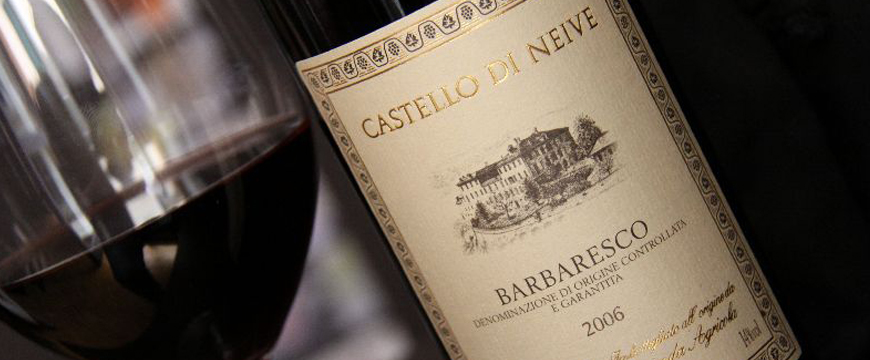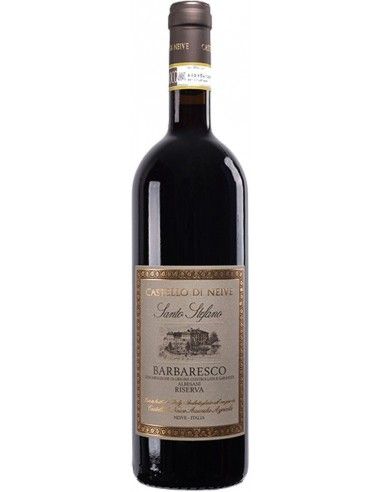-
All Products
TypeWineriesItalyRest of the WorldGreat Wines
- Barolo and its Crus
- Bolgheri
- Bordeaux and the French Bordelais
- Brunello di Montalcino iconic
- Chianti ancient tradition
- Supertuscan the Italian Bordeaux blend
- Syrah Millenary Tradition
- Great International Red Wines
- Great International White Wines
- Amarone in all its elegance
- Pinot Noir from the World
- Timorasso a jewel to discover
-
PROMOTIONS
PromotionsPromotions
-
Red Wines
ITALY Top Selection Red WinesWORLD Top Selection Red Wines
-
White Wines
ITALY Top Selection White WinesWORLD Top Selection White Wines
-
Rosé Wines
ITALY Top Selection Rosè WinesFRANCE Top Selection Rosè WinesWORLD Top Selection Rosè Wines
-
Sparkling
ChampagneItalian Sparkling WinesEnglish Sparkling Wines
- Other Wines
-
Spirits
Whiskey
-
Selections
Great Wines: focus onRare and Iconic WinesHeroic WinesWines to DiscoverAccessories
- Wine Makers
- .
Barbaresco 'Riserva S. Stefano' by Castello di Neive expresses the best of this Barbaresco cru, thanks to its prolonged refinement. For the Reserve, the grapes are vinified and smeared first for 6 months in steel, then for 18 months in French oak and finally for 6 months in glass. An excellent red for taste and scent. A perfect bottle as a gift.

- Product Category
- Red Wine
- Designation
- Barbaresco DOCG
- Grape / Raw material
- nebbiolo
- Aging Class
- Reserve
- Vintage or Cuvée
- 2015
- Size
- 750 ml.
- Country
- Italy
- Region
- IT - Piedmont
- Alcohol Content
- 14.5% vol.
- Service Temperature
- 18° - 20° C.
- Suggested Glass
- Large calyx with a long stem
- Special Features
- Limited Edition
- Food Matches
- Game, Red Meat, Aged Cheese
- Allergens
- Contains sulphites (by sulphites we mean the sulphur dioxide that is added to wine, to preserve it, thanks to its disinfectant, antioxidant and stabilizing action)

Castello di Neive and its 150 acre estate are owned by the Stupino brothers and sisters – Anna, Giulio, Italo e Piera. They were all born in Neive, and so were their parents, grandparents and great-grandparents.The history of the company began when their father, Giacomo, started to capitalize on both his experience as a surveyor and on his knowledge of the area, and to purchase, whenever possible, vineyards and land in extremely favourable locations. In the small cellars of their home, they began the first production of wine for domestic consumption and to sell in bulk.Messoirano, Montebertotto, Basarin, Valtorta, I Cortini;: the number of vineyards acquired by Giacomo grew and with it also the production and the ambitions of the family. In 1964 they purchased the castle with its spacious cellars, with more farmsteads in Santo Stefano and Marcorino, plus more land from the castle’s previous owner, Count Guido Riccardi Candiani.
This is was a turning point which urged the family to renovate the castle’s cellars, to reorganize the vineyards neglected by the previous owners and to produce wine according to modern methods. When Giacomo died, in 1970, Giulio end Italo oversaw the transition from tenant farming to direct management of the land, with the precious help of Talin Brunettini, skilful cellar man with a knowledge in agronomic techniques. It is at this time that Castello di Neive began to bottle its wines and to introduce them to the rest of Italy and abroad.
In 1978 another rewarding step: thanks to the collaboration between Italo and some experts from the University of Turin – professors Italo Eynard and Annibale Gandini – Castello di Neive started a clonal selection programme of Arneis, a grape long forgotten and abandoned because of its scarce productivity and lack of knowledge in white wine vinification. Arneis wine owes its rediscovery to this joint effort by the company and the University. In the past few years, Italo has devoted himself fully to the direct management of the company, under the name “Castello di Neive Azienda Agricola”: a devotion which seems to follow a ‘premonition’ contained in an old photograph: one depicting Mentor, Italo’s grandfather, presenting a grapevine to his young nephew.
Address:
Via Castelborgo, 1 - 12052 Neive (CN), Italy
Color: intense and brilliant garnet.
Bouquet: complex, intense and very wide, smelling small ripe fruit, tobacco, dried flowers, spices and cocoa, balsamic notes.
Taste: soft, warm, enriched with tannins.
- Bibenda 5/5
- Vitae 4/4
- WSC - Silver
- Luca Maroni 93/100
- Wine Spectator 90/100

There are no reviews
Reviews

THE WINE
Barbaresco 'Riserva S. Stefano' by Castello di Neive expresses the best of this Barbaresco cru, thanks to its prolonged refinement. For the Reserve, the grapes are vinified and smeared first for 6 months in steel, then for 18 months in French oak and finally for 6 months in glass. An excellent red for taste and scent. A perfect bottle as a gift.
THE COMPANY
Castello di Neive and its 150 acre estate are owned by the Stupino brothers and sisters – Anna, Giulio, Italo e Piera. They were all born in Neive, and so were their parents, grandparents and great-grandparents.The history of the company began when their father, Giacomo, started to capitalize on both his experience as a surveyor and on his knowledge of the area, and to purchase, whenever possible, vineyards and land in extremely favourable locations. In the small cellars of their home, they began the first production of wine for domestic consumption and to sell in bulk.Messoirano, Montebertotto, Basarin, Valtorta, I Cortini;: the number of vineyards acquired by Giacomo grew and with it also the production and the ambitions of the family. In 1964 they purchased the castle with its spacious cellars, with more farmsteads in Santo Stefano and Marcorino, plus more land from the castle’s previous owner, Count Guido Riccardi Candiani.
This is was a turning point which urged the family to renovate the castle’s cellars, to reorganize the vineyards neglected by the previous owners and to produce wine according to modern methods. When Giacomo died, in 1970, Giulio end Italo oversaw the transition from tenant farming to direct management of the land, with the precious help of Talin Brunettini, skilful cellar man with a knowledge in agronomic techniques. It is at this time that Castello di Neive began to bottle its wines and to introduce them to the rest of Italy and abroad.
In 1978 another rewarding step: thanks to the collaboration between Italo and some experts from the University of Turin – professors Italo Eynard and Annibale Gandini – Castello di Neive started a clonal selection programme of Arneis, a grape long forgotten and abandoned because of its scarce productivity and lack of knowledge in white wine vinification. Arneis wine owes its rediscovery to this joint effort by the company and the University. In the past few years, Italo has devoted himself fully to the direct management of the company, under the name “Castello di Neive Azienda Agricola”: a devotion which seems to follow a ‘premonition’ contained in an old photograph: one depicting Mentor, Italo’s grandfather, presenting a grapevine to his young nephew.
PHILOSOPHY
Due to his training as an engineer and to his previous activity in other fields too, Italo developed a scientific approach to the vineyard and to the countryside. Preserving tradition is one thing, but one can never take anything for granted and always must strive for better results. Questioning, researching, trying and learning: since the 1970’s the collaboration with the University of Turin has allowed Italo to enter the world of wine with a frame of mind which, still nowadays, enables him to face the challenges of a continuously evolving market. Tradition, research and creativity: this is the philosophy of a company which, without overlooking the heritage of centuries of winemaking, embraces new technologies, is active in the field of research – both in the vineyard and in the cellars – and is ready to take risks and to experiment.Thanks to this enthusiasm and creative drive, in the past years Castello di Neive has given birth to some new and stimulating experiences. Starting from 1996, the company has realized two wines aged in barriques - ‘I Cortini’, from pinot noir grapes and ‘Barbera d’Alba Superiore, from barbera grapes – and, since 2006, Langhe Albarossa. Besides, Castello di Neive has produced, from 1995, ‘Castello di Neive Classico’, a rewarding sparkling wine obtained exclusively from pinot noir grapes and ‘Castello di Neive Passito’, from withered arneis grapes.
TEAM
The collaboration between Castello di Neive and the University of Turin carries on today with the involvement – both in the cellars and in the vineyards - of professors Vincenzo Gerbi and Silvia Guidoni, with the belief that a lot still waits to be discovered about grapes and wine. In this context it is of great value to rely upon the advice of oenologist Gianfranco Cordero and agronomist Dino Bevione. To receive and translate into action all this information are the company’s own oenologist Claudio Roggero, and his right-hand man Marco Ion. The promotion of wines produced, in Italy and abroad, is followed directly by Italo Stupino with the support of his daughter Carolina. This is the spirit of our company and this is team that puts it in practice.
THE CASTLE
Neive owes its name to an important and noble Roman family “Gens Naevia”, or “Naevii” and became a municipality around the end of the 12th century. An old castle, perched on the top of the hill, existed even then, but was destroyed in 1274 during a military reprisal. In 1530 the Savoy kings of Piedmont acquired control of the territory and transformed Neive into a feud under the rule of Marquis Vittorio Amedeo Dal Pozzo, who became the first Count of Neive.At the beginning of the 18th century, the Count of Castelborgo, Manfredo Bongioanni, decided to build the new castle over foundations dating back to the 16th-17th century. The imposing structure is situated in what in medieval times had been Neive’s south-western border; a defensive wall complete with sentry boxes links the castle and its gardens to the Southern Gate of the town. The construction lasted several years and the date of completion can be traced back to 1753, when – as a memorial plaque testifies - the beautiful internal chapel was officially unveiled. Particularly remarkable is the baroque altar realized with marbles of different colours, quite unusual for a private residency. The castle’s cellars – where wine is still produced and bottled – were purposefully designed to serve the same function they do nowadays. They have very high ceilings to allow the use of big barrels. In these cellars, during the 19th century, the French oenologist and wine trader Oudart was operating as a consultant of the Count of Castelborgo. He was the first one in the area to obtain a dry, stable and therefore easily exportable wine from nebbiolo grapes: he called it ‘Neive’ and in 1857 this wine won a gold medal in London. The first ‘Barbaresco’ was produced thirty years later, using the same techniques employed by Oudart. The rest of the structure is partly used as a residence by the Stupino family, partly for receiving and entertaining: see the charming hall, music hall, dining room and gallery







